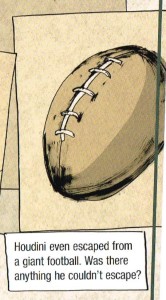 Since today is Super Bowl Sunday, I thought I would share the two times that I am aware of that Houdini escaped from a Giant Football:
Since today is Super Bowl Sunday, I thought I would share the two times that I am aware of that Houdini escaped from a Giant Football:
During an engagement at the Keith’s Theatre, a Boston sporting goods manufacturer had challenged Houdini to escape from a giant football. The magician was stuffed inside and a chain was passed through the eyelets and padlocked. After twelve minutes, Houdini reappeared, somewhat disheveled; but the ball appeared untouched, the stitching was intact. Years later, he repeated the stunt in Pittsburgh and had the entire University of Pennsylvania football squad carry the huge pigskin up the aisle and onto the stage.
The University of Pennsylvania football team was matched against Houdini on the stage of Keith’s Chestnut Street Theater in Philadelphia on January 4, 1907. The entire squad, in gridiron uniform, jogged down the aisle with a giant football (manufactured by the A.J. Reach Company) and lifted it up behind the footlights. They then manacled Houdini, bent him double to fit inside the opening of the ball. The handcuff king couldn’t turn around inside the football. The pigskin was laced with a brass chain and padlocked. The ball and Houdini was rolled into his curtained cabinet. Harry was out in thirty-four minutes.
Source:
- Houdini The Key by Culliton
- Houdini The Untold Story by Christopher
BONUS:
The following cut sequence is from the blue pages of the 1st PRELIMINARY GREEN April 23, 1952 Philip Yordan script for the Tony Curtis Houdini movie:
- WASHINGTON, D.C. SEQUENCE
On the stage at Keith’s theatre, eleven members of the Yale Football Team, wearing the football uniforms of the period, cart a giant leather football on to the stage.
H, clad only in bathing trunks and securely manacled, is put into the football through the opened lacing, then the players lace it up tightly.
A screen is put around the football. The football players ring themselves around the screen to make sure no outside assistance can be given H in his escape.
The orchestra plays the Yale Alma Mater Song. The audience is full of college students.
Suddenly H, wearing a Yale football uniform, comes running down the aisle from the back of the theatre, waving a pair of Yale pennants, to the amazement of the team and the audience.
On stage the football players pull away the screen revealing that the football is still tightly laced.
The audience goes wild.

You have to wonder:
1. Were the giant footballs just curiosities that the sporting goods people had already manufactured, or did they build these just to challenge HH?
2. Was this something HH orchestrated with the manufacturers to get them free publicity and ticket sales for him as in the Mirror Challenge?
3. If the answer to #2 is yes, then is it possible the footballs were already gaffed for release? Why not?
4. If the footballs were not gaffed, how the heck do you get out? The laces are also stitched through the inside so HH had access to them from the inside. Cut the laces/chains and replace with an undamaged set? Cutting away objects and replacing them afterwards was part of HH’s escape toolkit.
I believe they were built to challenge Houdini and get free publicity, but were not gaffed. I don’t believe he cut the laces/chains, but escaped the same way he got out of the “Sea Monster” which is described in “The Key”.
Perfect post for today. And I LOVE that cut scene from Houdini. Never knew about this one.
Thanks John! I thought you might like that scene. Enjoy the Super Bowl!
are they any picture of this?
I wish, but I am not aware of any pictures. I am not sure what Culliton’s source for Boston was, but the story from 1907 comes from an unidentified Philadelphia newspaper, Jan [15?] 1907 found in a scrapbook compiled by Houdini.
So Hollywood left out the Escape From a Giant Football, the Milk Can, and the plane to plane transfer from the Tony Curtis film. A little less dialogue and more action might have been better.
Hollywood left out others as well that didn’t make the cut. Click here to read my post from 2013 for more info.
Many of these challenges were arranged with local merchants in one of the first uses of mass tie-in marketing. Rather than promote the idea that he was assisted by spirits, as did the Davenport Brothers and others, Houdini’s advertisements showed him making his escapes via dematerializing , although Houdini himself never claimed to have supernatural powers.